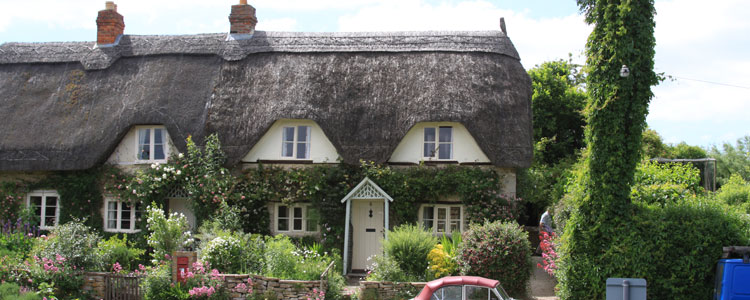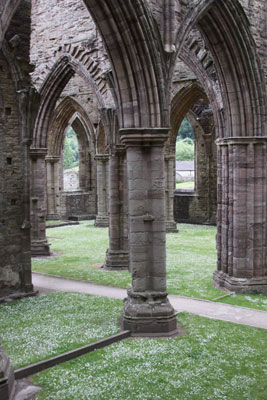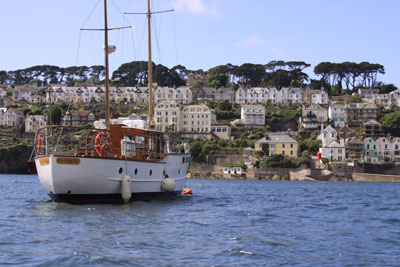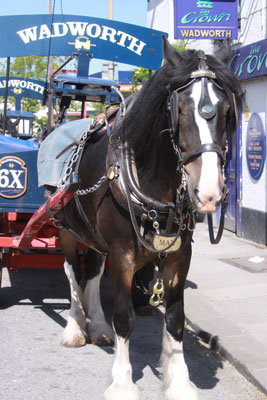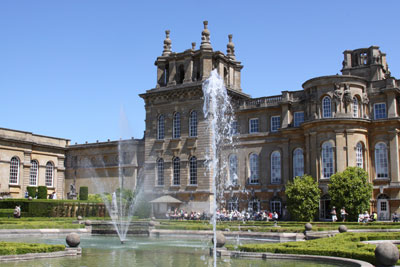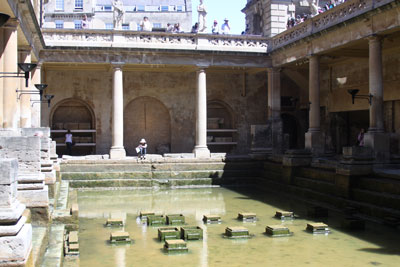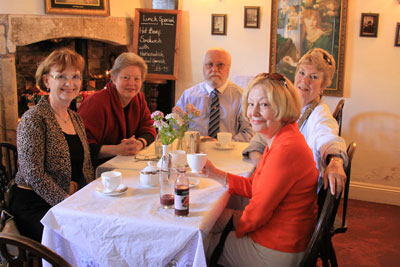A ramble through southwest England
by Lois Edwards, Greensboro, NC
It was easy to pick out our driver/guide, Anton Prole, at the arrivals area of Gatwick airport. He was the epitome of a proper British gentleman — ramrod-straight posture, perfectly trimmed moustache and beard, knife-sharp creases in his trousers and a twinkle in his eye.
My husband, Steve, and I had traveled to dozens of countries over the past 40 years, but we had never visited England. When we finally decided to make it our next destination, it wasn’t easy to find a trip to our liking.
We wanted to concentrate on the southwest, but we did not want to drive nor did we want to join a big bus tour that changed hotels every couple of nights. Then I remembered seeing the ad in ITN for Midway Motor Travel (Wiltshire, England; in North America, phone 800/214-8738). After a few e-mails and transatlantic calls, we were all set for our June ’10 tour.
Getting started
Anton had been in the process of arranging an itinerary for three ladies from Canada when we contacted him. The women had made numerous trips to England and were especially interested in visiting gardens. My husband and I were familiar with the country through novels and BBC productions, and our interest was more in the way of historical sights.
To lower costs, and with the permission of the other group, we decided to join them, and Anton was able to mesh our wish lists into a trip that suited everyone.
Our 14-day tour cost £4,625 ($7,214) and included 14 nights’ accommodations with daily breakfast, the services of a driver/guide and associated touring costs. We paid extra for airfare, other meals, entrance fees and gratuities.
One of our traveling companions ordered 15-day British Heritage Passes for us all at a cost of £73.50 ($115) each. These allowed us access to most sights at an overall savings. (I will note with an * the places included in the pass.)
After introductions and getting comfortably settled in our VW Caravelle, the six of us left Gatwick and headed to Devonshire. On the way, we stopped to visit Winchester Cathedral, an imposing structure at which to start the trip.
Begun in 1079 by a community of Benedictine monks, it has a Romanesque interior that is beautiful. It was a rainy day, and the light from the choir stalls and the many votive candles created a dramatic setting when the organ began to play.
An exhibit on “The Jane Austen Story” was next to her interment site there. (This was the first of several Jane Austen connections during the trip.)
My eye was caught by hand-painted letters of the alphabet, done in the style of medieval illuminated manuscripts and suitable for framing, that were available for purchase. Thinking they would make good gifts, I made a note to look for them in churches we would visit later, but I never saw them again.
After lunch in Milton Abbas, we walked along its main street, which had one of the best collections of thatched cottages in the area. In the 18th century, Lord Milton had the entire village relocated because it intruded on the view of his newly landscaped park. This rebuilding resulted in a homogenous grouping of thatched houses. One home was being rethatched that day and we were able to stop to watch the process.
Lyme Regis was our next stop. This was the setting for Jane Austen’s novel “Persuasion,” but it is most famous for being the home of Mary Anning, an early-1800s amateur fossil hunter who made several important discoveries along its seaside cliffs. The Philpot Museum* gave an interesting history of the town.
The Durant Arms (Ashprington, Devon; phone 01803 732240), an 18th-century country inn with eight rooms (en suite facilities), was a welcome sight. It would be our lodging for the next three nights. We were very pleased with our room in the half-timbered coach house with its view of the town market cross.
We had dinner two evenings in the inn’s excellent restaurant. Both small plates (chicken, ham or leek pie cost £9.45) and larger gourmet dinners (pork tenderloin with Stilton sauce, £15.95) were available.
None of the five of us had credit or debit cards with the infamous chip now widespread in Europe, but we had no problems. On using our cards, we advised the vendor that there wasn’t a chip, so they would swipe rather than scan the card.
Garden visits
Our first full day started at Greenway*, the former summer home of Agatha Christie. Open to the public only since 2009, it contains the family’s archaeological finds and vast eclectic collections. The grounds, with a fernery, a pet cemetery, a walled garden, ponds and statuary, made for a pleasant stroll.
In the van, a discussion of hedgerows segued to hedgehogs, which led to an impromptu visit to Prickly Ball Farm (Denbury Road near Newton Abbot; phone 01626 362319), a hedgehog-rescue facility.
With lambs, chickens and other farm animals available for petting and feeding, it would make a great stop for a family traveling with children (entry, £6.95). The presentation on the spikey little creatures was interesting, with everyone having an opportunity to touch the hedgehogs.
Coleton Fishacre* is an Arts and Crafts-style mansion built in the 1920s by the D’Oyly Carte family of Gilbert and Sullivan fame. The house was interesting, but it was overshadowed by the beautiful gardens with multiple terraces, a gazebo and a water feature. There was original art by local painters available at very reasonable prices.
The afternoon was capped off by a cruise through the peaceful countryside from Totnes to Dartmouth on the River Dart. While we had little time in Dartmouth, it looked like it would warrant a separate visit to spend time at the Britannia Royal Naval College and Butterwalk and roam the narrow streets with their half-timbered buildings.
Anton promised us the best fish-and-chips in the area at The Waterman’s Arms (Bow Bridge, Ashprington; phone 01803 732 214) that evening, but the food was outshined by the appearance of a troupe of morris dancers who performed right in the lane in front of the pub. Cars stopped and waited until the dancers broke for the next set.
Beau, the pub dog, furnished additional entertainment as he nudged onlookers to throw his ball again and again.
Stops along the way
Day three started with Buckland Abbey*, the former home of Sir Francis Drake. The abbey, founded by Cistercian monks in the 13th century, was converted to a country house by Drake’s rival, Sir Richard Grenville, before being sold to Drake by Grenville’s son. The abbey has many artifacts associated with both prior owners, including Drake’s Drum, which is said to sound on its own whenever England is in danger. There are also artists’ workshops and an Elizabethan garden.
Being a stained glass devotee, I was interested in Buckfast Abbey, known for its stained glass. However, we arrived at evensong, so I wasn’t able to get close access to the main window or visit the workshops. The Gregorian chants were beautiful, but, in retrospect, I would have to say that Buckfast would not be worth a detour for most visitors.
We spent three nights at the Lugo Rock Hotel (59 Melvill Rd.) in Falmouth, where we had a large, comfortable room with a water view. While there was no restaurant, the warm staff and excellent breakfasts made our visit there a pleasure.
Dinner that night was one of our best meals. The Pandora Inn (Restronguet Creek, Mylor Bridge) is in a gorgeous setting right along the River Fal. My three-course meal of baked goat cheese; scallops wrapped in prosciutto, and chocolate mousse with blood orange sauce and fresh berries was a delight (£25, or $39).
The next day provided an example of the flexibility offered by Midway Motors. I had expressed interest in two destinations that were not on our original itinerary. Our group mutually agreed to a revision to the previous plan and set off for the Eden Project (entry, £16).
Situated in an abandoned clay quarry and opened to the public in 2001, the project was conceived as a vision to communicate to the general public the importance of plants to the future of mankind and was opened to the public in 2001. Two controlled-environment biomes are the highlights.
One replicates a tropical rainforest and is the height of 11 double-decker buses. It duplicates the climates of Amazonia, West Africa, Malaysia and Oceania.
The second, smaller structure simulates a Mediterranean climate, reproducing conditions in Southern Europe, California and South Africa. Outside plantings continue the message of the symbiotic relationship between man and the environment. The Eden Project was educational, creative and fun. Plan on half a day at this unique site.
Quite a different landscape awaited us at the Lost Gardens of Heligan (£10). Covering approximately 200 acres, it was originally part of an estate that fell into decline in the early 1900s. Rescued in the 1990s, there are at least a dozen areas to explore, such as the Jungle Boardwalk, Woodland Walk, Medieval Sunken Lane and Lost Valley with its haunting mud people (sculptures integrated into the landscape).
Our last day in Cornwall was spent touring the coast. From the pretty fishing village of Porthleven, we headed to St. Michael’s Mount*, one of my must-see sights.
The Mount is a tidal island 400 yards from the town of Marazion. The man-made causeway is passable only at mid to low tide, but you can get to the island by boat at other times. There was a regatta taking place in the bay, with small, red-sailed boats flitting around the course.
Visitors to the buildings there can explore the armory, library, Blue Drawing Room and Chevy Chase Room. The latter was once the monks’ refectory and is now a dining room named for the plaster frieze of hunting scenes that circles the walls. If you are walking to and from the island, plan on spending at least three hours.
We were introduced to the Sunday carvery at our stop for lunch. Many pubs and restaurants have big buffets on Sundays with at least two meats and numerous side dishes. Prices are very reasonable at around £8-£9 per person.
Our next stop, Mousehole, is a gorgeous little village with steep narrow streets and flower-clad cottages leading down to a snug little cove protected by a granite breakwater. It is a real gem.
Penzance merited a drive through, but it seemed to be a holiday resort town with an overabundance of pirate references.
Bath and beyond
We were to spend five nights in Bath at the Villa Magdala (Henrietta Rd.). Originally two historic villas built in 1868, the lovely hotel is situated on a quiet street opposite Henrietta Park.
Fresh flowers from the owners’ garden are everywhere. Our room was very large and airy and we were only a few minutes’ walk from the center of town.
When the British talk about Bath, their faces light up. Founded, according to legend, in 863 BC by a Celtic prince whose ailments were cured by its hot springs, Bath became a center of Roman activity in AD 43. Built of the golden limestone called Bath stone, it seems to glow. The town was heavily bombed in 1942, but the historical town center, now a UNESCO World Heritage Site, was spared.
We started our time in Bath with a driving tour and history lesson, the highlights of which were the Circus and the Royal Crescent. Then it was elevenses (snack time) at the Pump Room, where, during the time of Jane Austen, who lived there briefly (1800-1805), society gathered to see and be seen.
Afterward we went to Bradford on Avon, a delightful little town with weavers’ cottages rising up the hillside from the river and a medieval stone bridge. This was the site of our much-anticipated Devon cream tea.
Anton made me promise not to reveal the name of the place voted the best tearoom in Britain in 2009 for fear of hordes of tour buses ruining it. I’ll just say that it had the perfect ambience for high tea, with low beamed ceilings, wait staff in Victorian costumes and thick, rich Devon cream.
The following day started in Devizes, originally an important cloth market town but now known as a canal transit center and the home of a large brewery. Wadworth Brewery is one of the last in Britain to deliver kegs to the local pubs by horse cart. We found the huge shire horses in front of Wadworth’s flagship pub, The Crown, and spent some time making our acquaintance with the gentle creatures.
Monumental landmarks
Stonehenge* has to be on the list of all first-time visitors to England, and we were no different. When seen from the roadway, the stones — up to 50 tons each — seem smaller than expected, but when you are closer you can sense the power and majesty that surround the site.
Another stop, Salisbury Cathedral, was magnificent. Unusual in that it was planned and executed in a single style though it was built in two phases, the silver-gray limestone building is Early English Gothic in its purest form.
We were lucky to have a volunteer guide who made the cathedral come alive. It houses the world’s oldest working clock (1386), 106 original choir stalls, dating from 1236, and the tomb of William Longespée, half brother to King John and an advisor on the wording of the Magna Carta.
But I was equally struck by how the cathedral transcends the past, continuing on as a living, evolving entity. Don’t miss the 1980 Prisoner of Conscience stained-glass window with the Amnesty International candle kept burning nearby, nor the 2008 baptismal font with its surface so smooth and clear that visitors set cameras and purses on it, only to watch them sink.
The cathedral’s Chapter House displays the best preserved of the four surviving original copies of the Magna Carta signed by King John in 1215.
Some independent touring
Steve and I were on our own in Bath the next day while our cohorts visited several houses and gardens in the countryside. We started off with a cruise up the Bristol Avon to Bathampton and back. The one-hour round trip was serene. The cruises leave from the riverside below the shop-lined Pulteney Bridge. Across from the bridge is the old Guildhouse Market, now a warren of shops selling hardware, cloth, food — you name it.
We also paid a visit to Bath Abbey, begun in 1499 by a bishop following a dream in which he saw angels climbing to heaven and heard voices commanding him to build a church. The west façade has tall stone ladders with delightful statues of angels climbing up and down.
The abbey is known as the Lantern of the West due to the quality of its stained-glass windows. The east window, with 56 scenes from the life of Christ, is noteworthy.
History buff that I am, the Roman Baths* were my cup of tea. They are located on the opposite side of the busy square in front of the abbey and the Pump Room.
The Romans built a spa there around AD 54 and dedicated it to the goddess Minerva. The multimedia tour through the baths offers a glimpse into life in Roman times and is geared to all age groups. It’s a “must see” if you visit Bath.
We had a late lunch at the Riverside Café (17 Argyle St.), built into the steps below Pulteney Bridge. Steve had a great Welsh rarebit with bacon while I had a steak-and-Stilton sandwich (£17 total).
Picturesque points of interest
Following a day trip to Wales, we all were off to the Cotswolds, where we visited Kelmscott Manor (£8.50). Originally a Tudor farmhouse, Kelmscott became the country home of William Morris, famed poet and craftsman.
The house is filled with tapestries, drawings and wall coverings designed by Morris, his wife and daughters. It is surrounded by the gardens that inspired much of his work.
The property has limited hours (2011 hours are 11 to 5 every Wednesday and Saturday, April 2-Oct. 29) and an excellent gift shop.
The afternoon was a procession of one lovely village after another: Bibury, with its 17th-century weavers’ cottages along a trout stream; Burford, a collection of limestone houses the color of honey; Bourton-on-the-Water, where children were wading in the shallow Windrush River; Stow-on-the-Wold, situated at the junction of seven roads, and Broadway, our home for the next two nights.
Our stay was at the Cowley House (Church St.), an 18th-century farmhouse and granary. We were pleased with our very nice, newly renovated room overlooking the garden and enjoyed the two playful resident West Highland terriers. However, others in our group found the service wanting.
Breakfast was again excellent, with options of Welsh rarebit or scrambled eggs with smoked salmon. The ingredients all were local — a welcome trend we found at many of the places at which we ate.
Names of note
We had arrived at the end of the inaugural Broadway Arts Festival, nine days of competitions and exhibitions commemorating the work of painter John Singer Sargent. We walked through the celebration on the village green that evening. Tables were set up, with families and friends meeting and greeting with champagne in hand while children ran around playing tag. There was also entertainment, with a very credible Barbra Streisand impersonator (named Peter). The next festival is scheduled for June 8-17, 2012.
We started the next day at Warwick Castle*, billed as Britain’s “ultimate castle.” While it verges on the Disneyesque, there is no denying that a visit is great fun. The main castle hosts a Royal Weekend Party à la 1898 (visitors are announced as they enter the drawing room), with the Prince of Wales and a young Winston Churchill in attendance. The Great Hall, Staterooms and Chapel appear as they would have in the 1700s.
A walk up the Mound to the first, wooden fortifications (from 1068) provides a view of the trebuchet, a Middle Ages siege machine. There is also the Princess Tower for little girls and the Castle Dungeon (costing extra) for the brave at heart.
For some reason, I chose to walk the ramparts and towers — an exercise in masochism. I wouldn’t recommend it, as it really didn’t add much to the experience.
From the frenetic activity of Warwick we headed to Stratford-upon-Avon. While there are numerous sites associated with William Shakespeare, we chose to concentrate on the most well known: Anne Hathaway’s Cottage*, the family home of Shakespeare’s wife, in nearby Shottery. Across the street, the Cottage Tea Garden provides shade, a peaceful setting and excellent baked goods.
The last stop of the day was Hidcote*, one of England’s great gardens. Beginning in 1907, self-taught gardener Lawrence Johnston spent 41 years creating a series of outdoor garden “rooms,” each with its own character and offering a surprise at every turn.
Hidcote was the first property acquired by the National Trust solely for its garden; there is no tour of the house. The 30 separate garden rooms include the White Garden, Rock Bank, Red Borders and Rose Walk, to name a few.
One final day
Originally, our last day was going to include a tour of “Midsomer Murders” villages, since several of us were devotees of the television series, but on the previous night we decided to change the plan. Instead, we first went to St. Martin’s Church in Bladon to view the grave of Winston Churchill, who is buried in his family’s plot. It was touching to see the resting place of this great man in the simple parish church.
Bleinheim Palace* also has a strong link to Churchill: it was his birthplace. The 18th-century palace, a gift from Queen Anne to John Churchill, the first Duke of Marlborough, was magnificent. But even more interesting was the exhibit devoted to Winston Churchill. We heard recordings of his most famous speeches while viewing letters, pictures and artifacts from his life and career.
The second floor housed “Blenheim Palace: the Untold Story,” an exhibition that tells the history of the residence through the eyes of the household staff.
We found Midway Motor Travel a good match for our needs. The compatible small group, unique hotels, Anton’s vast knowledge of the countryside and, above all, the flexibility in the schedule made for a great trip.

